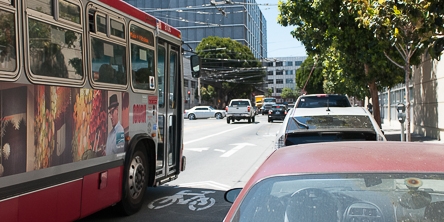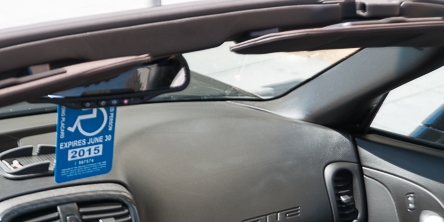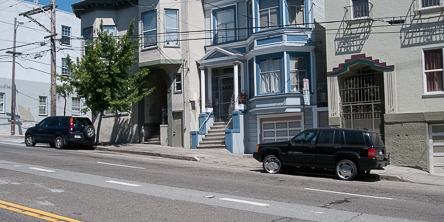72 Hour Maximum
18 Inches or Less from Curb
Face the Flow of Traffic
Curb Your Tires
Check Your Bumpers
Check for Signs
Don't Park in the Same Place in Permit Areas
Don't Use Objects to Claim On-Street Parking
Parking is Allowed After Sweeping
Watch for Tow-Away Zones
Driveways, Sidewalks and Crosswalks
Watch For Crosswalks
Disabled Placards
Permits & Street Sweeping
Video Explanations
72 Hour Maximum
In the absence of other posted restrictions, such as residential parking permit (RPP) zones, street sweeping, meters or posted time limits, a regular-sized passenger vehicle or motorcycle is allowed to park in one spot for up to 72 hours without being cited for overtime parking. Vehicles parked beyond the maximum 72 hour limit may be issued a warning in the form of a Marking Notice affixed to the vehicle’s windshield, and one or more of its wheels may be marked at the same time. Having a current (or temporary) RPP decal for the same RPP zone, or a displayed DP placard, does not provide an exemption from this overtime restriction.
If you do not return to move the marked vehicle by the date and time listed on the Marking Notice, the vehicle may be towed for being parked overtime when the SFMTA enforcement officer returns to its previously marked location. A Marking Notice found missing on the overtime vehicle does not affect the enforcement officer’s authority to tow when the officer returns to the marked location.
This overtime parking restriction is generally enforced by the SFMTA as a result of one or more initial complaints from residents who have concerns about vehicles being stored or abandoned in their neighborhoods. The SFMTA requests that residents wait for approximately 72 hours before complaining about a stored or abandoned vehicle—a policy that tends to help prevent harassment or abuses of the overtime parking program. However, there is no 72 hour (or 3-day) waiting period before a 72 Hour Marking Notice may legally be affixed to the vehicle that is identified by a resident’s complaint.
Vehicles found parked on public streets without current DMV registration (i.e., more than six months out of reg., and without a current Dealer’s Notice of Sale or paper plate), or that are parked in a hazardous location that obstructs traffic or access to one or more driveways, or that are obviously disabled and inoperable—may be cited and towed immediately, whether or not they have been issued a 72 Hour Marking Notice.
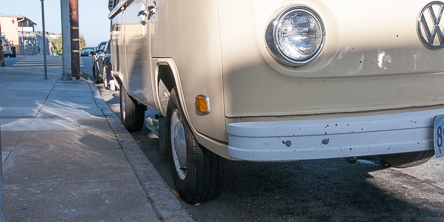
18 Inches from the Curb
When parking parallel (with the side of your car against the curb), make sure your wheels are within 18 inches of the curb.
Face the Flow of Traffic
Don't park against the flow of traffic. Your vehicle must face in the direction of the flow of traffic, even if it is otherwise parked legally.
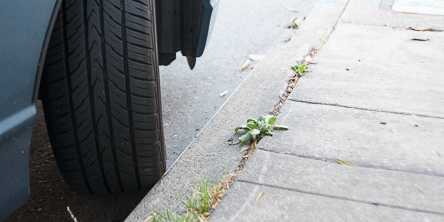
Curb Your Tires on Hills
When you park (3% grade or more) angle your front wheels so if your vehicle were hit or its brakes were to fail, it would roll into the curb and not into traffic.
- On a sloping driveway, turn the wheels so the vehicle will not roll into the street. Set your parking brake.
- Headed downhill, turn your front wheels into the curb or toward the side of the road. Set your parking brake.
- Headed uphill, turn your front wheels away from the curb and let your vehicle roll back a few inches. The wheel should gently touch the curb. Set your parking brake.
- Headed either uphill or downhill when there is no curb, turn the wheels so the vehicle will roll away from the center of the road if your brakes fail.
- Always set your parking brake and leave the vehicle in gear or in “park” or “P” position.
You can confirm the grade of your street by going to the Department of Public Works (DPW) Street Grade Map. DPW Street Grade Map
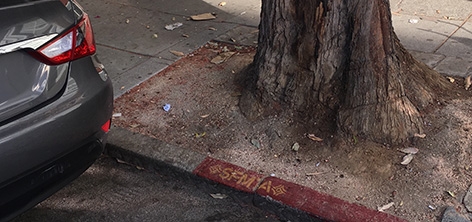
Check Your Bumpers
Check your front and rear bumpers to make sure they are not extending into a driveway, crosswalk or color zone.
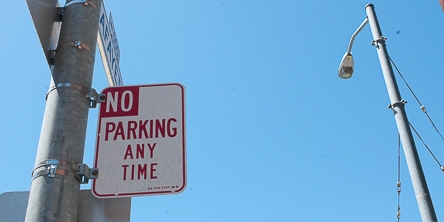
Check for Signs
Always check for posted parking and street sweeping times. Look 100 feet in both directions for any sign. Please call 311 to report any defaced, deficient or missing parking signs.
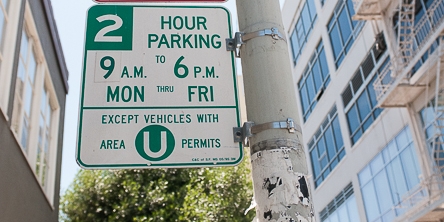
Don't Park in the Same Place in Permit Areas
In permit areas you must move your vehicle after the posted time limit (typically 1 to 2 hours) if you don't have a permit. The law requires you to move one block away or at least one-tenth (1/10) of a mile—about 500 feet. Do not drive around and then park in the same block, or you can be ticketed!
Need a permit? A, Z, or any letter in between, here's the information on Residential Parking Permits
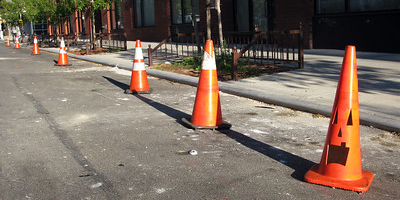
Photo credit: Poster Boy
Don't Use Objects to Claim On-Street Parking
Don't use objects like traffic cones or trash cans to claim on-street parking spots. If you need a temporary "No Parking" or "No Stopping" zone for a moving van or special event, you may request one through SFMTA's Temporary Signage Program. Temporary Signage Program Information
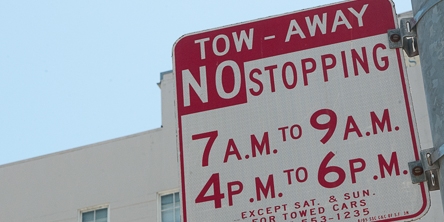
Parking is Allowed After Sweeping
Sweeping the streets keeps them clean, and street sweeping citations discourage vehicle owners from blocking the street sweeping truck's path. Once the street sweeping truck has swept the curbside, you may park your vehicle there, even if the posted sweeping hours have not expired.
Department of Public Works' Street Sweeping Information
Watch for Tow-Away Zones
Some parking zones become tow-away zones during commute hours. Check the meter face and posted signs for tow-away restrictions.
Driveways, Sidewalks and Crosswalks
DRIVEWAYS, SIDEWALKS & HILLS
- Do not block driveways or crosswalks. A driveway begins at the "curb cut," where the curb begins to slope downward toward street level.
- Do not park on sidewalks. A sidewalk citation can be given even if the pedestrian travel path is partly clear or if the vehicle is parked across a driveway. This includes motorcycles and bicycles that impede pedestrian paths.
- Curb wheels when parking on a hill of any perceptible grade. When parking facing uphill, turn the steering wheel toward the street. When parking facing downhill street, turn steering wheel toward the sidewalk. We also recommend parking letting your vehicle wheels rest against the curb to keep it from rolling.
Give Driveway Owners Space to Get In and Out
A driveway begins at the top of the sloped edges, or the “curb cut.” Some driveways may have red tips—red curb coloring on the curb cuts and space adjacent to it. Parking in the red tip or within the cut curbs may result in your vehicle being cited and/or towed.
Park In Your Own Driveway
- You may park in your own driveway as long as no portion of your vehicle extends over the sidewalk or into the required setback.
- So please do not park on the sidewalk or within the required setback. San Francisco's Planning Department provides more information, including a list of common planning code violations. San Francisco Planning Code Violations
- You can confirm the width of your sidewalk by going to the San Francisco Public Works (DPW) Street Grade Map. DPW Street Grade Map
- Follow DPW's instructions by entering the street name, limits/(cross street), keymap number, block number or block lot number.
- Press search.
- Under "Key Map Results" click on "grade".
- Allow your browser to open the map.
- On the map you will find your sidewalk's width numerically listed in feet along with the symbol for feet ('). As an example 15' represents 15 feet.
- For further answers please contact DPW at: 628.271.2000
- Residents may block their own driveway by parking parallel to the curb or street, only if the vehicle’s license plate is registered to the building’s address, and provided that such driveway serves no more than two family dwelling units (a permit is not required). However, it is illegal to park in any marked or unmarked crosswalks. Never block disabled curb ramps located inside or adjacent to crosswalks.
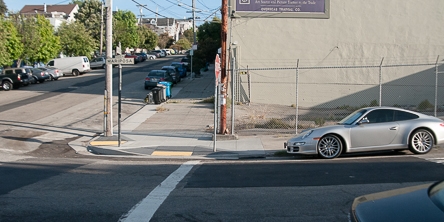
Watch for Crosswalks
It is illegal to park in any marked or unmarked crosswalks. Never block curb ramps located inside or adjacent to crosswalks. Leave at least 20 feet (or one large car length) between a marked or unmarked crosswalk and your vehicle, so approaching vehicles can see the pedestrians.
Disabled Placards
With a properly displayed disabled placard or disabled license plate (including one issued by a different state or country) you may park in any of the following zones, so long as the person to whom the placard is issued is being transported:
- Blue zones
- General metered parking zones without paying
- Green zones
- Residential Permit Parking areas
- Areas with posted time limits (e.g. a one-hour zone in a business district)
However, a disabled placard does not allow you to park in the following times or places:
- No-parking, no-stopping or other red zones
- During street-cleaning hours
- During posted commercial loading hours (look for signs, yellow curb, or yellow or red meters)
- During posted passenger loading hours (look for signs or white curb)
- During posted commuter tow-away hours (check for tow-away signs within 100 feet in both directions of a parking space)
- For more than 72 hours in any space.
A disabled placard does NOT exempt the vehicle from all other citation and/or tow-away rules and restrictions.
PERMITS & STREET SWEEPING
- In areas with time limits, do not park in the same spot or on the same side of the street. After you move your car, we recommend parking on another block. The law requires you to move one block away or at least one-tenth of a mile from your vehicle’s first recorded parking position. This will ensure the parking enforcement officer does not ticket you for disobeying the time limit.
- Always check for parking and street sweeping signs. Look 100 feet in both directions for any parking signs and check the curb to see if there are any color curb markings. During street sweeping hours, you may not park until the street has been physically swept. Please call 311 to report any defaced, deficient or missing parking signs.
EXERCISING COURTESY
Some parking practices are perfectly legal, just not very nice. You may not get a ticket for parking bumper-to-bumper, but you can be kind to your neighbors by using these rules of thumb:
- Don't let your bumpers touch. Leave at least 18 inches of space between cars when parking parallel so that your neighbors can access their trunks, or drive away without having to bump into your vehicle.
- Report faded curb colors. Where the curb has faded, vehicles will not be cited for curb color violations. Help us keep the colors bright and up to date by calling 311.
- Maximize availability. In areas where there are not spaces marked by painted lines, pull as close to the vehicles in front or behind you as possible while leaving enough space for them to exit.
How You Can Help
Give Others Room to Park
Maximize availability. In areas where there are not spaces marked by painted lines, pull as close to the vehicles in front or behind you as possible while leaving enough space (18 inches) for them to exit. Irregular space between parked cars may be caused by motorcycles and small vehicles.
Report Broken Meters and Faded Curbs
Where the curb has faded so badly as to be difficult to determine the curb color, it will not be enforced for curb color violations. And while you may only park at a broken meter for the posted time limit or four hours, whichever is shorter, functioning meters guarantee better parking availability for everyone. Help us keep meters working and curb colors bright and up to date by calling 311. By calling 311 you'll create a record so that the curb or meter will be evaluated.
"HOW DO I...?"
Simply dial 311 in order to:
- Report a malfunctioning parking meter.
- Request a faded color curb be repainted.
- Give feedback about the conduct of a parking enforcement officer.
- Ask any question about parking enforcement, bar none.
- Make any request. We are here to serve you!
Video Explanations
The videos below cover some of the advice written on this webpage.
How to Avoid Muni and Parking Tickets
Riding Muni or driving in San Francisco? This short video breaks down what you need to know about paying your Muni fare, how to avoid Muni and parking tickets, and how to get help if you’re low on funds.
To watch in Spanish or Chinese, click the below links:
What to do if you get a Muni or parking ticket in San Francisco
If you get a Muni or parking ticket, you have options. In about 60 seconds, you can learn all about them from the video above.
Want to watch in Spanish or Chinese? Click these links:
